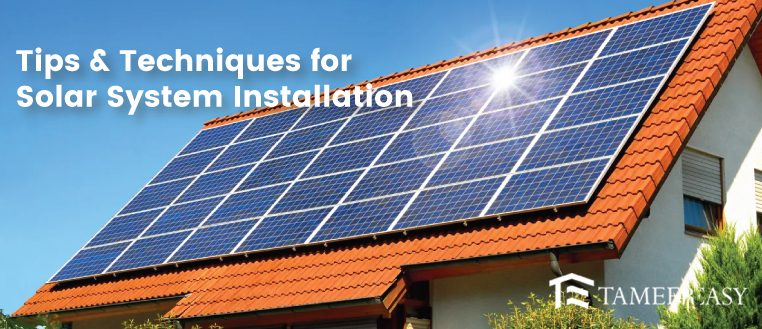Solar energy is being used increasingly as a clean, renewable energy source. As more individuals and businesses embrace solar power, proper installation becomes crucial for the optimal performance and longevity of the solar system. In this article, we will discuss ten top tips and techniques to follow during solar system installation.
Solar System Installation – Top Ten Tips & Techniques
Whether you are a homeowner considering solar panels or a professional installer, these guidelines will help ensure a successful and efficient installation process.
1). Site Assessment and Shading Analysis
Before installing a solar system, it is essential to conduct a thorough site assessment. Assess the available space, orientation, and inclination of the roof or ground area where the panels will be installed.
Additionally, perform a shading analysis to identify potential obstructions such as trees, chimneys, or nearby buildings that may cast shadows on the panels. Optimising the system’s placement and avoiding shading can maximise your solar installation’s energy output and efficiency.
2). Energy Consumption Analysis
Analyse your energy consumption patterns to determine the appropriate size of the solar system. Review your historical energy bills to understand your average monthly energy usage. This analysis will help you accurately size your solar system to meet your energy needs.
Avoid oversized or undersized methods, as they can impact the system’s efficiency and return on investment. Consult a solar professional to ensure you choose the right system size based on your consumption patterns.
3). Superior Components and Expert Installation
Select reputable manufacturers known for their reliability and efficiency. Choose an experienced and certified solar installer to ensure a professional installation. Proper installation techniques, compliant with industry standards, will minimise the risk of malfunctions and ensure the system’s longevity.
Professional installers will handle the installation’s electrical connections, proper grounding, and structural integrity.
4). Compliance with Local Regulations
Learn about the local rules and procedures for obtaining permits for solar installations. Obtain the necessary permits and ensure compliance with building codes, zoning restrictions, and safety regulations.
Adhering to these guidelines will prevent potential legal issues and ensure the safety and quality of your solar system. Consult with local authorities or engage a solar professional knowledgeable about your area’s requirements.
5). Optimal Inverter Placement
Place the solar system’s inverter in a suitable location. The inverter converts the direct current (DC) the solar panels generate into usable alternating current (AC) electricity. Consider the distance between the inverter and the main electrical panel to minimise energy losses during transmission. Adequate ventilation will prevent overheating and ensure efficient operation.
6). Proper Wiring and Electrical Connections
Follow industry standards and the manufacturer’s guidelines for wiring sizes, connections, and grounding. Poorly executed electrical work can lead to voltage drops, system inefficiencies, and safety hazards.
It is advisable to engage a licensed electrician or a solar professional for the electrical aspects of the installation. Regularly inspect the wiring and connections to identify and promptly address potential issues.
7). System Monitoring and Maintenance
Implement a reliable monitoring system to track the performance of your solar installation. Monitoring software provides real-time data on energy production, system efficiency, and potential issues. Regularly review the monitoring reports to identify any underperforming panels or equipment.
8). Effective Roof Preparation
Before installing solar panels, ensure that your roof surface is in good condition and can bear the weight. If necessary, repair any existing roof damage or replace worn-out shingles.
Additionally, consider installing a roof mounting system that protects the roof surface and allows for proper water drainage. Proper roof waterproofing preparation will not only safeguard your investment but also extend the lifespan of your solar installation.
9). Consider Future Expansion
Evaluate your future energy needs and whether you may require additional solar panels. Design the initial installation with expansion in mind, such as reserving space for future panels or ensuring sufficient capacity in the inverter. A forward-thinking approach during installation will make expanding your solar system easier and more cost-effective as your energy requirements grow.
10). Educate Yourself and Engage Professionals
Take the time to educate yourself about solar energy and the installation process. Understand the basic principles, components, and benefits of solar power. Familiarise yourself with reputable resources, such as industry publications and reliable websites, to stay updated on the latest advancements.
While it’s important to know, engaging professionals for a successful solar installation is equally crucial. Consult with experienced solar installers, engineers, and electricians who can provide expert advice and ensure compliance with safety standards and best practices.
Conclusion
From site assessment and compliance with regulations to using high-quality components and engaging professionals, each step plays a vital role in the performance and longevity of your solar system. Embrace the power of solar energy and contribute to a greener future while maximising the benefits of your solar installation.








